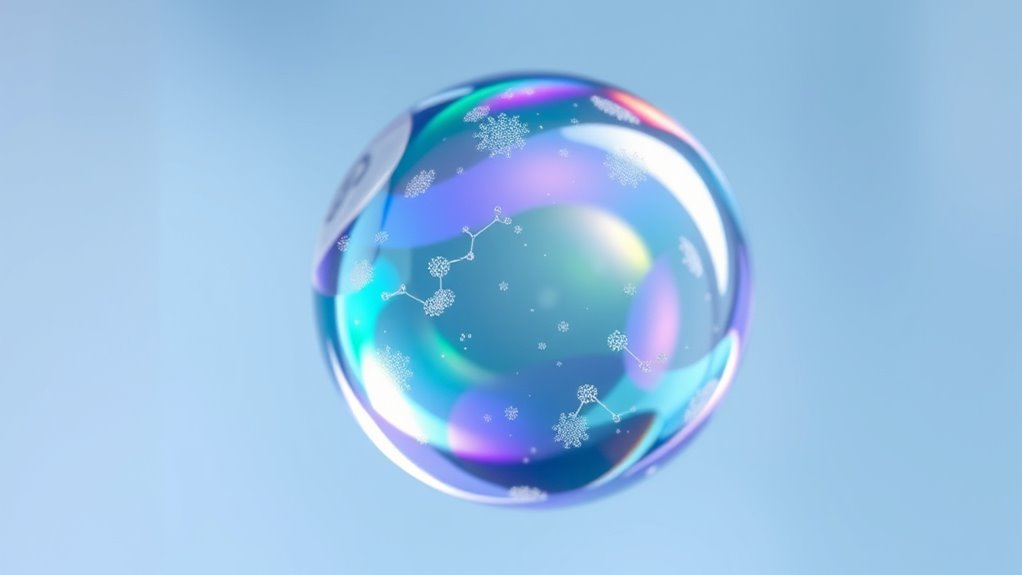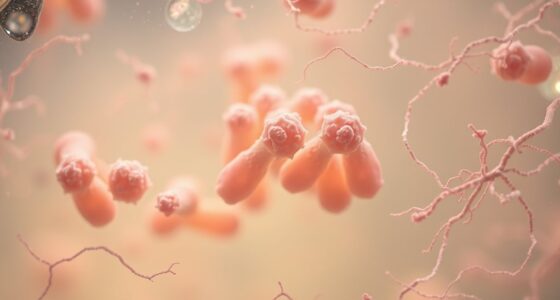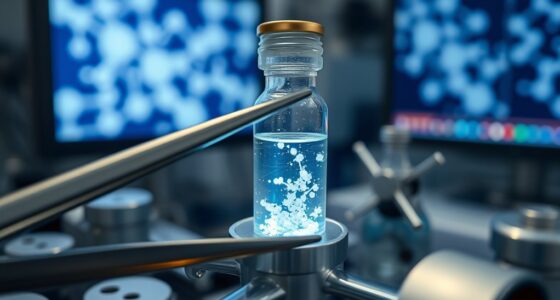Lipid nanoparticles (LNPs) play a vital role in mRNA therapeutics by encapsulating and protecting the fragile mRNA molecules during delivery. They are designed to fuse with cell membranes, allowing the mRNA to enter target cells efficiently. These delivery systems optimize stability, provide protection from enzymatic degradation, and guarantee the mRNA remains functional until it reaches its destination. Discover how advances in lipid nanoparticle chemistry can improve treatment effectiveness by exploring further details.
Key Takeaways
- Lipid nanoparticles (LNPs) protect mRNA from enzymatic degradation and facilitate cellular entry.
- LNP composition balances stability, biocompatibility, and efficient mRNA delivery.
- Lipid fusion with cell membranes enables effective mRNA release into the cytoplasm.
- Delivery chemistry involves optimizing lipid formulations for stability, storage, and targeted delivery.
- Advances include chemical modifications of mRNA and innovative LNP designs to enhance therapeutic efficacy.

Have you ever wondered how scientists can turn a tiny piece of genetic code into a powerful treatment? mRNA therapeutics do exactly that by using messenger RNA to instruct cells to produce specific proteins, helping the body fight diseases or replace missing ones. This innovative approach has revolutionized vaccine development, especially demonstrated during the rapid creation of COVID-19 vaccines. The key to its success lies in ensuring mRNA stability, which is vital for the therapeutic to remain intact long enough to reach its target cells and produce the desired proteins effectively.
One of the biggest challenges in mRNA therapeutics is protecting the fragile messenger RNA from degradation. Naturally, RNA molecules are prone to breaking down quickly once outside the protective environment of cells. To address this, scientists have developed sophisticated delivery systems, with lipid nanoparticles (LNPs) playing a central role. These tiny fat-based carriers encapsulate the mRNA, shielding it from enzymes that would otherwise destroy it and facilitating its entry into cells. Without LNPs, the mRNA would have a hard time surviving the journey through the bloodstream and reaching the target tissue.
Lipid nanoparticles protect mRNA from degradation and enable efficient delivery into cells.
Lipid nanoparticles are designed not just for protection but also for efficient delivery. They are composed of lipids that can fuse with cell membranes, allowing the mRNA payload to slip inside the cell. Once inside, the cell’s machinery reads the mRNA instructions, producing the specific proteins needed, such as the spike protein in COVID-19 vaccines. This process triggers the immune response, training your body to recognize and combat the actual virus. The chemistry of these lipid carriers is carefully optimized to balance stability, biocompatibility, and delivery efficiency.
Ensuring mRNA stability is at the core of making these therapies effective. Scientists modify the mRNA structure itself—using chemically altered nucleosides—to make it less prone to degradation and less likely to induce unwanted immune reactions. They also optimize the formulation of lipid nanoparticles to maintain stability during storage and transport, often requiring ultra-cold temperatures. These innovations guarantee that the mRNA remains intact from manufacturing through administration, ensuring patients receive a potent, effective dose.
In essence, the synergy between advanced delivery chemistry and meticulous mRNA stabilization techniques has unlocked the potential of mRNA therapeutics. Lipid nanoparticles serve as both protectors and delivery vehicles, ensuring the fragile messenger RNA reaches its destination intact. This combination has not only accelerated vaccine development but also opened doors for treating a range of diseases, from genetic disorders to cancer. As research progresses, these delivery systems will only improve, making mRNA therapies more accessible, stable, and effective for future generations.
Frequently Asked Questions
How Do Lipid Nanoparticles Protect Mrna From Degradation?
Lipid nanoparticles protect mRNA from degradation by providing a stable lipid environment that shields it from enzymes. Their lipid stability guarantees the mRNA remains intact during delivery. You’ll find that high encapsulation efficiency helps trap the mRNA securely inside, preventing exposure to harmful factors. This combined protection allows the mRNA to reach target cells effectively, ensuring successful gene expression without premature breakdown.
What Are the Latest Advancements in Delivery Chemistry for Mrna?
Think of mRNA delivery as a stealthy courier racing through a busy city. Recent advances focus on targeted delivery, like GPS-guided drones, ensuring the message reaches specific cells efficiently. Researchers are also enhancing immune evasion, making the delivery system less detectable by the immune system’s watchdogs. These innovations improve mRNA stability and effectiveness, paving the way for more precise, safe, and potent therapeutics.
How Scalable Are Current Lipid Nanoparticle Manufacturing Processes?
You’ll find that current lipid nanoparticle manufacturing processes are becoming increasingly scalable, but production challenges remain. Advances in automation and continuous production methods help improve scalability, allowing larger quantities of mRNA therapeutics to be produced efficiently. However, you should stay aware of challenges like maintaining quality and consistency at high volumes. Overcoming these hurdles is essential for meeting global demand and ensuring reliable, cost-effective delivery of mRNA medicines.
What Are the Potential Side Effects of Lipid Nanoparticle-Based Mrna Therapies?
Lipid nanoparticle-based mRNA therapies can sometimes trigger immune reactions, like an uninvited guest crashing your party, leading to inflammation or mild side effects. Off-target effects may occur if the mRNA reaches unintended cells, causing unforeseen responses. While generally safe, some individuals might experience allergic reactions or other side effects. Monitoring and refining delivery methods help minimize these risks, ensuring your body’s response stays harmonious rather than chaotic.
How Can Delivery Systems Be Customized for Different Tissue Targets?
You can personalize delivery systems by attaching targeting ligands specific to your tissue of interest, enhancing tissue specificity. By selecting ligands that bind to unique receptors on certain cells, you improve delivery efficiency and reduce off-target effects. Adjusting the lipid composition and particle size also helps optimize penetration and uptake. This strategic customization ensures that your mRNA therapies reach the intended tissue, increasing their efficacy and safety.
Conclusion
So, next time you marvel at a vaccine, imagine tiny lipid nanoparticles throwing a wild party inside your cells, delivering mRNA like secret agents on a covert mission. Thanks to clever chemistry, these microscopic messengers evade immune guards and deliver their payloads with flair. It’s almost like a high-stakes heist, but instead of stolen jewels, you get protection. Who knew molecular delivery could be the star of such a blockbuster?









